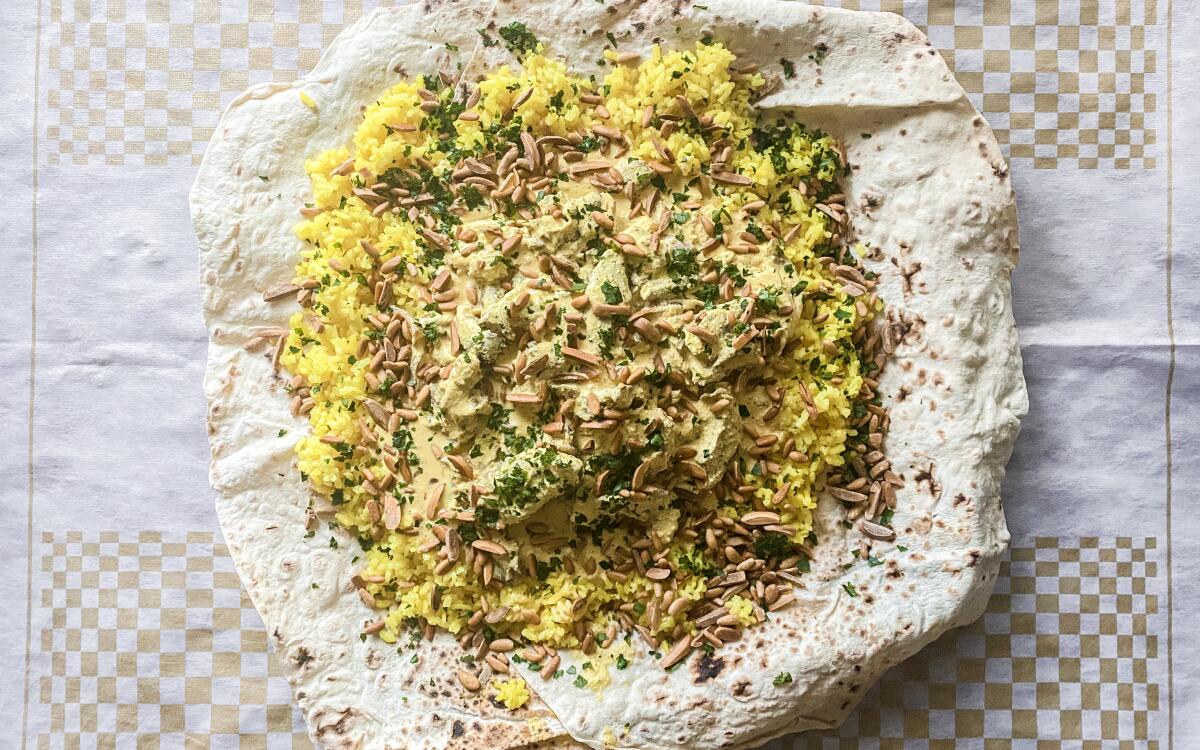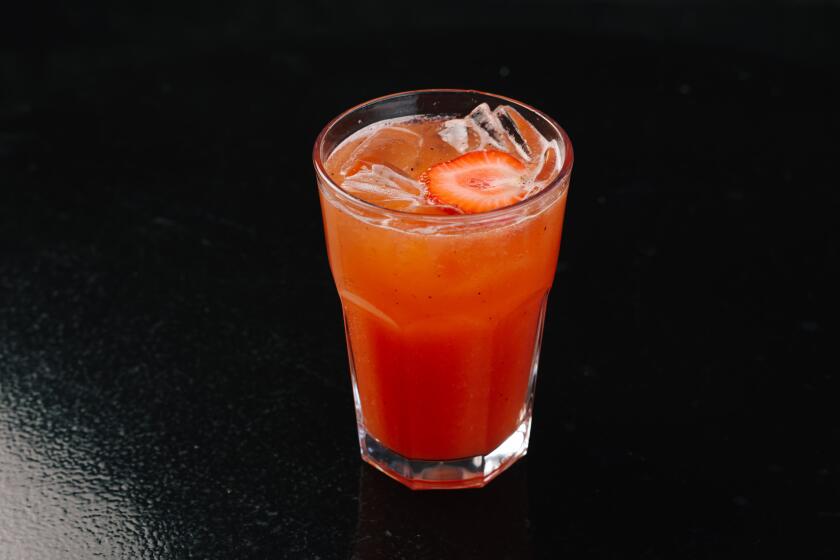Mansaf

- Share via
Mansaf is a typical Bedouin dish that comes from Hebron in the West Bank. It is served at large family gatherings, for celebrations or simply to honor special guests. Traditionally it was made with a whole lamb, with the lamb’s head proudly placed in the middle of the dish to indicate that the animal had been slaughtered for the occasion; but nowadays it is more often than not made with a shoulder, leg or shanks. The meat is cooked in a yogurt sauce made with jameed, or dried yogurt.
Jameed is how Bedouins preserve the milk from their goats. To make it, the yogurt is drained in cotton sacks to remove the whey and salted every day until it thickens. The sacks are regularly rinsed with water on the outside to get rid of every trace of whey. The strained yogurt is then rolled into balls (either round or with a pointed top) and set to dry in the shade (if dried under direct sun, the jameed will be yellow instead of white) until the balls of jameed are rock hard to the core, after which they are stored away.
Jameed is mixed with water to reconstitute it before being used in this dish. You can also make mansaf with fresh yogurt, although the flavor will not be as sour (the fermentation process gives jameed a particular flavor that imparts a faintly sour taste to the lamb as it cooks). I personally use a mixture of jameed for the sour flavor and fresh yogurt for creaminess. I have adapted the recipe below from one I found in a small Arabic cookbook, “The Palestinian Kitchen.” In the original recipe, the lamb is cooked in the yogurt-jameed mixture from the outset, but the yogurt can curdle during such long cooking, so I boil the lamb separately, then finish it in the yogurt sauce. While the flavor may not be quite so intense, the consistency of the sauce is creamier. You can also make mansaf with chicken but the dish will not be as celebratory as when made with lamb.
Put the shanks in a large pot and cover with water. Add the onion and cinnamon stick and bring to a boil over medium-high heat, skimming the froth from the surface. Reduce the heat to medium-low, season with salt to taste, cover and simmer for 1 hour or until the meat is tender.
Meanwhile, knead the jameed in its soaking water to help it dissolve completely. Strain the liquid into a large pot in case there are still little pellets of undissolved jameed. Add the Greek yogurt and bring to a boil over medium heat, stirring constantly to prevent the yogurt from curdling. Stir in the allspice, cinnamon, black pepper and saffron. Remove from the heat as soon as the yogurt comes to a boil. Cover the pan with a clean kitchen towel and keep warm.
Melt the butter in a small pot. Stir in the turmeric and then add the rice, stirring it in the butter until well coated. Add 1 liter (4 cups) water and season with salt to taste. Bring to a boil, then reduce the heat, cover and simmer for 10 to 15 minutes, or until the rice is tender and the water is fully absorbed. Wrap the lid in a clean kitchen towel and replace over the rice.
Meanwhile, heat the oven to 425 degrees.
Spread the pine nuts and almonds on separate nonstick baking sheets and toast in the oven until they turn golden brown (5 to 6 minutes for the pine nuts, 7 to 8 minutes for the almonds). Remove from the oven.
Remove the cooked lamb from the broth and take the meat off the bone. Drop the boiled lamb into the yogurt sauce and place the pan over low heat. Bring to a simmer, stirring all the time, adding a ladle or two of broth until you have a sauce the consistency of light cream. Taste and adjust the seasoning if necessary.
To serve, lay the bread over a large round serving platter. Spread the rice over the bread, then arrange the meat over the rice. Ladle as much yogurt sauce as you would like over the meat and rice without making the dish soupy. Pour any leftover sauce into a sauceboat. Garnish with the toasted nuts and serve immediately.
Saj Bread
Mix the flour and salt in a large bowl. Add 200 milliliters (¾ cup plus 1 tablespoon) water. Mix until you have a rough ball of dough.
Transfer the ball of dough to a lightly floured work surface and knead for 3 minutes. Shape into a ball and invert the bowl over the dough and let rest for 15 minutes. Then knead for 3 more minutes until you have a smooth firm dough.
Divide the dough into 10 portions, each weighing about 40 grams (1½ ounces). Shape each into a small ball, rolling the dough between the palms of your hands. Then roll the ball of dough against your work surface — which should not be floured — keeping the side with the seam against the work surface to seal it. Sprinkle a tray or part of your work surface with flour and place the balls of dough on the floured surface. Cover with a damp kitchen towel. Let rest for 30 minutes.
Roll out each ball of dough — here it is a good idea to use a thin rolling pin like the Turkish oklava — sprinkling with flour every now and then, until you have a round 17½ to 20 centimeters (7 to 8 inches) in diameter. Lace the rounds of dough in between floured couches (baker’s linen), or simply use floured kitchen towels.
Heat a large nonstick pan over medium heat until very hot. Add the dough rounds, one at a time, and cook for a minute or so on each side. They should be lightly golden with small burned spots where they have bubbled up. Stack between clean kitchen towels. You can serve these immediately or use them to make wraps. Or you can do what the Turks do and stack them in a dry place, where they will keep for weeks.
When you are ready to serve, sprinkle each bread with a little water to soften, fold it in half and wrap in a clean kitchen towel. Let rest for 30 minutes so that it becomes soft and pliable and ready to serve.
If dried jameed is not available, use 355 milliliters (1 1/2 cups) prepared jameed stock or soup.
Get our Cooking newsletter.
Your roundup of inspiring recipes and kitchen tricks.
You may occasionally receive promotional content from the Los Angeles Times.














